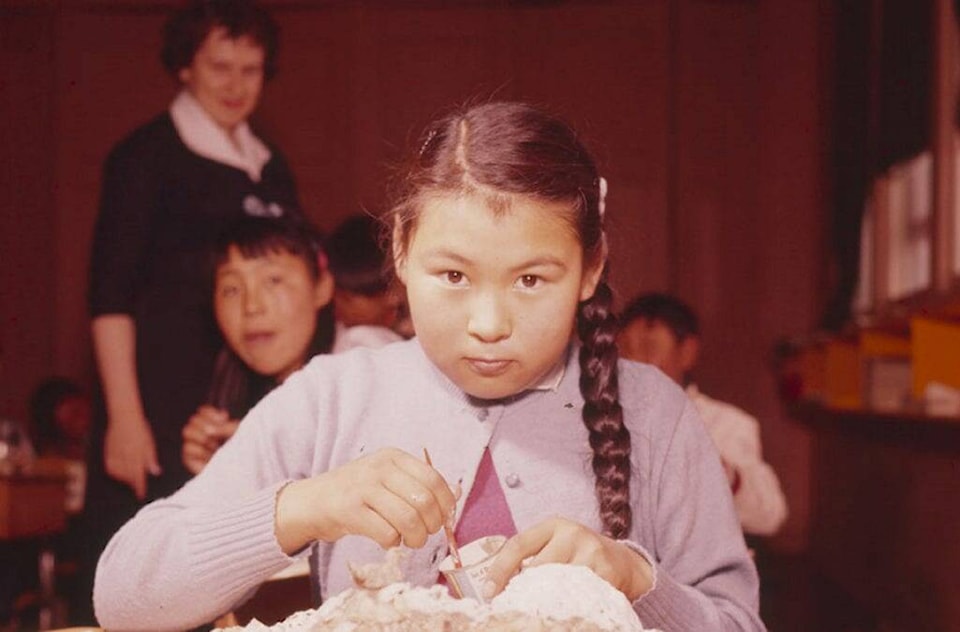In May of 1968, Mary Zinnow’s family lost their home in Apex to a fire, and with it, all of their photos.
Now 78 years old, she went most her life without seeing a picture of herself as a girl, but recently came across one in a 2020 Nunavut News article.
The photo was taken in 1958, when Zinnow was a student at Apex School, a short distance from Iqaluit, which was then called Frobisher Bay and part of the Northwest Territories. The woman in the background is her old teacher, Shirley Smith, who she describes as lovely.
“I have no pictures of myself from when I was a little girl,” Zinnow said of the Library and Archives Canada photo. “I’m lucky to have that picture that we’re looking at right now.”
She was born in Frobisher Bay on July 23, 1945. She said she was the third baby born in the community. Her full name, at that time, was Mary E7-452 – the product of a Government of Canada system that identified Inuit by numbers in place of surnames.
When Zinnow discovered the photo in question, a wave of memories came flooding back.
She spent most of her childhood living in Apex. Her father worked for Hudson’s Bay Company, and they lived in a “little house” that his employer provided.
She remembers her father would trap foxes on the land around their home, and says he taught her to shoot in the springtime, when “all kinds of birds” descended on a pond near their house. Her mother, meanwhile, would take her down to the beach to collect clams, and their harvests were so bountiful that they often struggled to carry their buckets. Through it all, she recalls appreciating the natural splendour of her surroundings, from the expanses of seaweed near the beach, to the crystal clear water, to the berries that cropped up every summer.
“Oh, it was so beautiful,” she said. “We had a wonderful life.”
Zinnow has fond memories of the people in the area at the time too. There were only a few families around at that point, and she said they were all “so close to each other.”
There were also many Americans in town, working at the Frobisher Bay air base. She said the Americans were “so good” to her, and recalls attending the movies they would screen in a building next to the hospital.
She said the Americans once distributed soup and supplies to families when there was an illness spreading across town and, at other times, would give out products like coffee, bacon, peanut butter, cookies and dried apples. Once, she devoured their gifts so quickly that she made herself sick.
“We ate all of it,” she laughed. “I remember being so sick. I was throwing up.”
’The dark side of life’
Those idyllic days did not last for Zinnow, as her father eventually left his job with Hudson’s Bay Company to pursue a career as an electrician in Kingston, Ont., and she moved with her mother from their longtime home in Apex to Iqaluit, where they stayed with family.
It was around that time, she recalled, that she became aware of “the dark side of life.” By that point, alcohol had begun to seep into the community, and it affected many people around her. She also started drinking herself, and ultimately ran away from home.
She didn’t get sober until 1984.
By that time, she had married twice: first to a man from Kinngait when she was a teenager, and later to a German man she met in Montreal. She met her second husband in 1979, in the city’s East End, and later discovered that they lived right beside each other in the city centre. They married in Iqaluit a year after that happy coincidence, and she took his last name. Today, they live together outside Grande Prairie, Alta.
Zinnow has a son in his 50s and another in his 40s. She had a daughter who died in 2012, which is when she was last in Iqaluit. She admits that her drinking put a strain on her relationships with her daughter and other family members, but she hopes they know she loves them with all her heart.
“When I was young, I was confused,” she said. “I have regrets.
“I’m thankful for my family. They’ve gone through a lot with me.”
She said her life “has been much better” since she got sober, and that she’s happy in Grande Prairie.
She learned to garden. She goes to church. She volunteers on National Indigenous Peoples Day and Canada Day. She gives presentations on her life in Nunavut at a local school.
“Life is good here,” she said. “I have a good life.”
Despite being thousands of kilometres from Iqaluit, she’s still immensely proud of her Inuit heritage. Stumbling across a photo from her childhood in Apex helped reinforce that pride, and she hopes sharing her story will ensure that others don’t forget how people in the area used to live.
“A lot of things were coming to my mind [when I saw the photo]” she said, fighting back tears. “God is good to me. God loves me and he doesn’t forget who I am.
“I’m Inuk and nobody can change it,” she added. “I don’t want it to get lost, how we used to live in the past.
“There was harmony, there was peace, there was respect, and there was love.”
